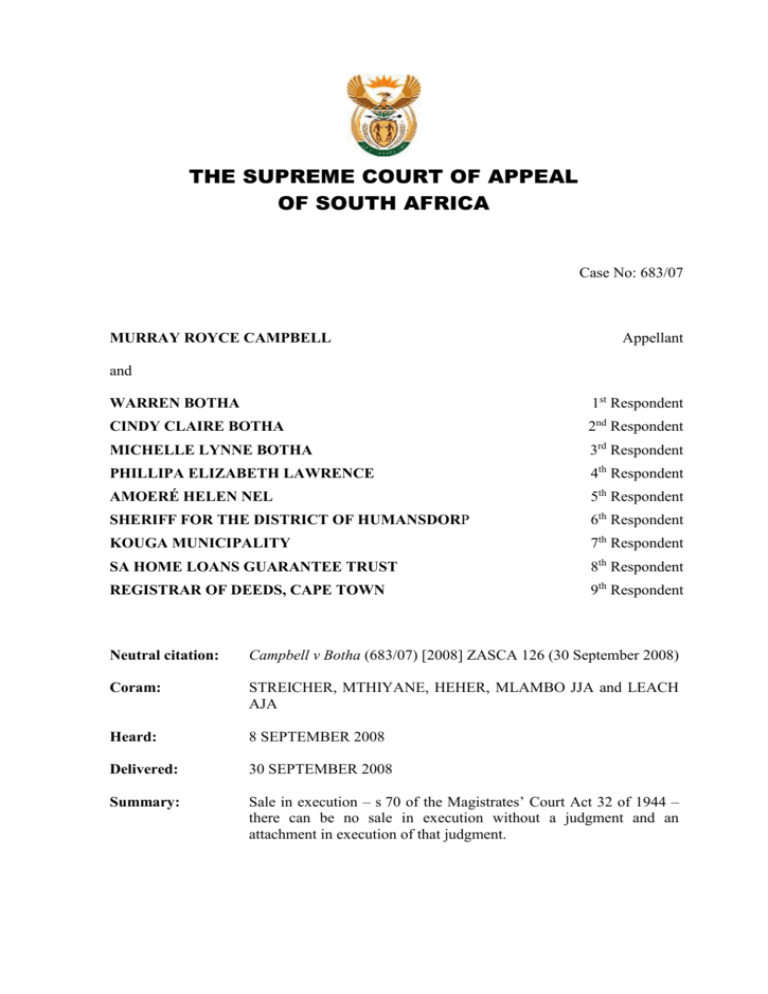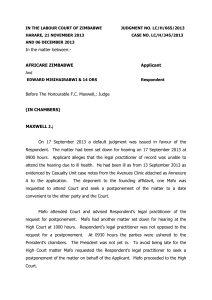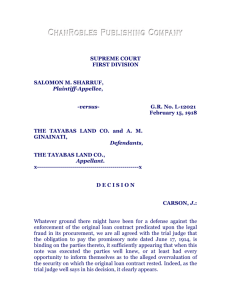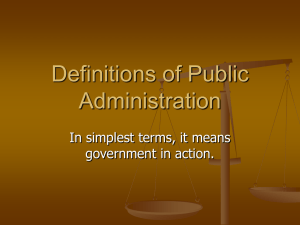the supreme court of appeal
advertisement

THE SUPREME COURT OF APPEAL OF SOUTH AFRICA Case No: 683/07 MURRAY ROYCE CAMPBELL Appellant and WARREN BOTHA 1st Respondent CINDY CLAIRE BOTHA 2nd Respondent MICHELLE LYNNE BOTHA 3rd Respondent PHILLIPA ELIZABETH LAWRENCE 4th Respondent AMOERÉ HELEN NEL 5th Respondent SHERIFF FOR THE DISTRICT OF HUMANSDORP 6th Respondent KOUGA MUNICIPALITY 7th Respondent SA HOME LOANS GUARANTEE TRUST 8th Respondent REGISTRAR OF DEEDS, CAPE TOWN 9th Respondent Neutral citation: Campbell v Botha (683/07) [2008] ZASCA 126 (30 September 2008) Coram: STREICHER, MTHIYANE, HEHER, MLAMBO JJA and LEACH AJA Heard: 8 SEPTEMBER 2008 Delivered: 30 SEPTEMBER 2008 Summary: Sale in execution – s 70 of the Magistrates’ Court Act 32 of 1944 – there can be no sale in execution without a judgment and an attachment in execution of that judgment. 2 _______________________________________________________________ ORDER _______________________________________________________________ On appeal from: High Court, South Eastern Cape (Froneman J sitting as court of first instance) 1 The appeal succeeds with costs. 2 The order by the court a quo is substituted with the following order: ‘1 It is declared that (a) The applicant is the owner of Erf 1115 Sea Vista, in the Kouga Municipality, Division of Humansdorp, Eatern Cape Province. (b) The applicant never lost his ownership of the erf pursuant to the sale of the erf by the sixth respondent to the fifth respondent. 2 The other relief claimed by the applicant stands over for later determination. 3 The first, second, third and fifth respondents are ordered to pay the costs incurred in respect of the relief granted.’ ____________________________________________________________ JUDGMENT ____________________________________________________________ STREICHER JA (MTHIYANE, HEHER, MLAMBO JJA and LEACH AJA concurring) [1] The appellant applied to the Eastern Cape High Court for an order declaring that he is the owner of Erf 1115 Sea Vista situated in the Kouga Municipality in the Eastern Cape Province (‘the property’) and for certain ancillary relief. The court a quo dismissed the application but granted the appellant leave to appeal to this court. 3 [2] The appellant was born on 1 January 1980. On 30 September 1998 he, assisted by his father and natural guardian, purchased the property for a purchase price of R20 000. The property was transferred to him on 29 December 1998. At all relevant times he made use of his father’s postal address namely P O Box 5015, Helderberg, 7135. However, as a result of a mistake either on the part of the conveyancing attorney or the Kouga Municipality (the seventh respondent) his address came to be incorrectly recorded in the records of the Municipality as P O Box 5012, Helderberg, 7135. He failed to pay the rates payable in respect of the property and on 12 June 2000 the Kouga Municipality issued summons in the Humansdorp Magistrate’s Court against him for payment of an amount of R3 311,91 being due in respect of outstanding rates plus interest. At that time he was still a minor but the Kouga Municipality failed to cite him as being assisted by his father. It cited him as ‘M R Campbell, an adult male of whom further particulars are to the plaintiff unknown of P O Box 5012, Helderberg, 7135’. An attempted service of the summons by mail was unsuccessful as a result of which the Kouga Municipality obtained the leave of the court to effect service by way of publication of a notice of the proceedings in the Cape Argus newspaper. The notice was published in the Cape Argus but did not come to the attention of the appellant or his father. No appearance to defend was entered as a result of which a judgment by default was granted to the Kouga Municipality on 19 October 2000. At that time the appellant was still a minor. [3] A warrant of execution against the property was thereafter issued and on 23 November 2000 the court granted leave to the Kouga Municipality to serve the warrant of execution by one placement thereof in the Cape Argus. However, there is no record that service of the warrant was effected in terms of the court order. On 30 March 2001 the sheriff for the district of 4 Humansdorp, sold the property at an auction which purported to be a sale in execution. [4] A professional assistant in the employ of the appellant’s attorneys, Ms Vreugde, undertook a search in the microfilm records of the National Library of South Africa at Cape Town. She stated that she examined every edition of the Cape Argus published during the period 14 November 2000 to 30 March 2001 and established that the warrant of execution had never been published. All that had been published was the court order authorising service of the warrant by way of publication thereof in the Cape Argus. That publication took place on 2 February 2001. It would seem that, by mistake, the court order was published and not the warrant. Another indication that the warrant had not been published is the fact that Mr Nel, the attorney of the Kouga Municipality at the time when the warrant should have been published, produced copies of the advertisement of the sale in the Government Gazette and in the Herald newspaper but could not do so in respect of the advertisement of the warrant. [5] Nel simply denied that the warrant had not been published. He stated that Mr Coetzee who was the sheriff at the time was a meticulous sheriff who ensured that every procedure was followed prior to a sale in execution; that the records on microfilm may not be complete; and that Vreugde may have missed the particular advertisement. The respondents also filed an affidavit by Coetzee in which he stated that he had been a sheriff for 39 years and that in all those years not a single sale in execution that he had arranged had been set aside on the basis that he had not followed the correct procedures. Prior to each sale he meticulously went through each and every notice and judicial document pertaining to the sale so as to insure that the procedures had been followed properly. I do not think that these 5 averments are sufficient to create a dispute of fact. The microfilm records of the National Library are available for inspection. In addition, hard copies of the Cape Argus are kept by the National Library as well as by the University of Cape Town. Had the Kouga Municipality and its attorney Nel considered it possible either that the microfilm records were not complete or that Vreugde failed to conduct a proper search, they should have investigated the matter themselves as they had been invited to do. It is not good enough to say that the records may be incomplete or that Vreugde may not have searched properly or that Coetzee was meticulous. Even meticulous people make mistakes. For these reasons I am satisfied that the appellant established that the warrant had not been published. [6] Nel’s wife, the fifth respondent, bought the property at the auction for an amount of R3 500 and sold it on 6 November 2002 to the fourth respondent for R20 000. The fourth respondent had a dwelling constructed on the property and on 11 February 2004 she sold it at a price of R560 000 to the third respondent. The third respondent in turn effected certain improvements on the property for a total amount of R552 016,94 and on 23 March 2006 she sold an undivided third share in the property to the first and second respondents jointly. The first, second and third respondents thereupon caused a mortgage bond to be registered over the property in favour of the eighth respondent to secure a loan that had been granted to them. [7] During or about July 2004 the appellant discovered that he was no longer the registered owner of the property. On 16 February 2005 he launched an application for the rescission of the judgment against him. The application was dismissed but an appeal against such dismissal was upheld on the ground that the judgment was void ab origine on account of the 6 appellant’s lack of capacity to be sued. The appellant then paid the amount claimed in the proceedings whereupon the Kouga Municipality withdrew the action against him and tendered a refund of the amount paid. The tender was not accepted by the appellant. [8] Relying on these facts and tendering to pay to the first, second and third respondents or to such of the respondents as may satisfy the court that they are entitled to it, the difference between the value of the property with improvements and the value of the property without improvements, the appellant applied for orders declaring that he is the owner of the property and that he never lost his ownership of the property pursuant to the purported sale in execution. He submitted that there could not have been a valid sale in execution as there was no valid judgment in existence and as there had not been an attachment of the property. [9] Section 70 of the Magistrates’ Courts Act 32 of 1944 provides: ‘A sale in execution by the messenger shall not, in the case of movable property after delivery thereof or in the case of immovable property after registration of transfer, be liable to be impeached as against a purchaser in good faith and without notice of any defect.’ The respondents submitted that the sale was protected by the section as the fifth respondent as purchaser had acted in good faith and without notice of any defect. [10] The judge a quo said ‘that the purpose of section 70 would be undermined if courts are too easily disposed to find that irregularities in the execution process leads to the conclusion that a sale in execution was a “nullity”’. He held that at the time of the purported sale in execution there was ‘an actual court judgment in existence which was only set aside in November 2005’ and added that he was ‘not aware of authority for the 7 proposition that once immovable property has been transferred under a sale of execution the sale can be set aside upon the basis only of the rescission of the original judgment’. He further assumed that only the order granting leave to publish the warrant of execution had actually been published in the Cape Argus and not the warrant itself but held that the failure to publish the warrant was not ‘an irregularity of such a nature to invalidate the sale in execution’. Referring to the fact that the publication of the summons and the judgment had not elicited any response from the applicant or his father and that notice of the sale was published in the Government Gazette and the Eastern Province Herald prior to the sale, he concluded that the sheriff substantially complied with what was formally required of him. [11] In terms of s 70 a sale in execution of immovable property may not be impeached after registration of transfer as against a purchaser in good faith and without notice of any defect. Section 66 provides that when a court gives judgment for the payment of money such judgment, in case of failure to pay such money forthwith shall be enforceable by execution against immovable property if there is not found sufficient movable property to satisfy the judgment. Such execution is to be effected by an attachment of the immovable property and a sale of the attached property in execution.1 It follows that there can be no sale in execution without a judgment and an attachment in execution of that judgment.2 See in this regard Reid and another v Godart and another 1938 AD 511 where De Villiers JA said at 514: ‘[T]he word “execution” means, as it seems to me, “carrying out” of or “giving effect,” to the judgment, in the manner provided by law; for example, . . . by a levy under a writ of execution.’ 1 2 Rule 43. The same view is expressed in Joosub v J I Case SA (Pty) Ltd and others 1992 (2) SA 665 (N) at 673C. 8 Referring to this passage Friedman JP said in Jones and others v Trust Bank of Africa Ltd and others 1993 (4) SA 415 (C) at 419G-H: ‘What is protected by s 70 is a “sale in execution”. A sale in execution is one which follows upon a judgment of the court. The section, which was held in Sookdeyi’s case to codify the common law, does not, in my judgment, protect a sale which does not follow upon a judgment of the court.’3 [12] In Menqa and another v Markom and others 2008 (2) SA 120 (SCA) this court had to consider the ambit of the section. A judgment had been granted against Markom and pursuant to that judgment his property was attached in terms of a warrant of execution and sold by the sheriff at a sale which was conducted as a sale in execution of that judgment. On appeal this court upheld the finding of the court of first instance that the warrant of execution was invalid in that it had been issued by the clerk of the magistrate’s court without judicial supervision as is required in terms of s 66(1)(a) as amended by the constitutional court in Jaftha v Schoeman and others; Van Rooyen v Stoltz and others 2005 (2) SA 140 (CC).4 In the judgment of the majority the absence of judicial supervision imperilled Markom’s constitutional rights under s 26(1) of the Constitution and rendered the sale to Menqa invalid. Van Heerden JA said that to hold that the provisions of s 70 rendered such a sale unimpeachable would defeat the purpose of the constitutional ruling in Jaftha.5 In a minority judgment Cloete JA, with whom Scott JA concurred, agreed with these findings of the majority but considered it desirable to analyse the meaning of s 70 and provide a rational basis for its interpretation.6 3 See also Maharaj Brothers v Pieterse Bros Construction (Pty) Ltd and another 1961 (2) SA 232 (N) at 238. 4 Menqa paras [15] and [28]. 5 At paras [21]. 6 At para [28]. 9 [13] Having referred to Roman-Dutch authors Cloete JA disagreed with passage in Sookdeyi and others v Sahadeo and others 1952 (4) SA 568 (A) at 572D-E where Van Den Heever JA said in respect of s 70: ‘Had the section not contained the words “in good faith and without notice of any defect”, a sale in execution by the messenger would after delivery or transfer have been absolutely unassailable.’ He did so in the following terms:7 ‘These dicta cannot be supported to the extent that they suggest that s 70 limits the circumstances under which a sale in execution in a magistrates’ court can be impugned, after delivery of movables or transfer of immovables, to the two cases mentioned in the section.’ I do not consider it necessary to express a view on the correctness of Cloete JA’s view. Van den Heever JA did not say that absent a judgment and a attachment, a sale would be unassailable had the purchaser acted bona fide and without notice of any defect. He was referring to a sale in execution and not to a purported sale in execution. As stated above, a sale in execution, in the present context, is a sale following upon a judgment and an attachment in execution of that judgment. Without a judgment and an attachment in execution of that judgment there can be no sale in execution. [14] The judgment which gave rise to the sale in Sookdeyi was a judgment against minors unassisted by a guardian. A minor has no locus standi in judicio with the result that the judgment was void.8 However, the judgment in fact existed and was treated as a judgment which could form the basis of a sale in execution entitled to the protection afforded by s 70. [15] In the present case the judgment that gave rise to the sale of the property was similarly a judgment against a minor unassisted by a guardian and therefore void. But, as in the case of Sookdeyi, the court a quo held that 7 8 At 140A-B. Boberg’s Law of Persons and the Family 2 ed p 906. 10 the judgment did in fact exist at the time when the sale took place and that that judgment, which was rescinded only after the sale, could form the basis of a sale in execution entitled to the protection of s 70. [16] To treat such a judgment as one that can form the basis of a sale in execution protected by s 70 would seem to be at odds with the following statement by Innes CJ in Lewis & Marks v Middel 1904 TS 291 at 303: ‘[T]he authorities are quite clear that where legal proceedings are initiated against a party, and he is not cited to appear, they are null and void; and upon proof of invalidity the decision may be disregarded, in the same way as a decision given without jurisdiction, without the necessity of a formal order setting it aside (Voet, 2, 4, 14, and 66; 49, 8, 1 and 3; . . ..’ Voet 49:8:3 says: ‘But by the customs of today such over stressful and pettifogging discussion on fine points of law as to whether a decision is ipso jure void, or holds good by strict law and must be set aside through the remedy of an appeal, has been as far as possible abolished. The ruling has rather prevailed that decisions are never annulled under cover of nullity without appealing. There are exceptions when the nullity arises from a lack of jurisdiction, or of summons or of an attorney’s mandate, . . . .’ And Voet 2:4:66 says: ‘Summons to law moreover, either verbal or physical, is the beginning of the institution of all actions; and if it is left out none of the succeeding steps can hold good. The result is that a judgment pronounced gains no force even in favour of the person who has not been summoned and for that reason does not appear.’ But then dealing with the fact that a judgment in favour of a minor unassisted by his guardian is valid and enforceable against the other party, stated that ‘in that case the needful constituent and foundation of the judicial proceeding was not wanting; for even minors, when they better their condition, have a lawful persona standi in judicio without a curator . . .’. 11 [17] Cloete JA9 is of the view that Van Den Heever JA’s statement is obiter but, in the light of the conclusion to which I have come in respect of the attachment of the property, I do not consider it necessary to determine whether that is in fact so or to determine whether Van den Heever JA was correct in considering a judgment against a minor unassisted by a guardian to be a judgment that could form the basis of a valid sale in execution. In this regard it should be pointed out that it was apparently not argued in Sookdeyi that the judgment could not have formed the basis of a valid sale in execution. It would seem that the sole issue before the court was concerned with the incidence of the burden of proof in respect of the bona fides or knowledge of the purchaser at the sale in question.10 [18] An attachment is effected by way of a notice by the sheriff served together with a copy of the warrant of execution upon the execution debtor as owner, upon the registrar of deeds, upon all registered holders of bonds registered against the property, if the property is in the occupation of some person other than the execution debtor, also upon such occupier and upon the local authority in whose area the property is situated.11 Whatever the position may be if service is not effected on any of the other interested persons there can, in my view, never be said to have been an attachment where neither the warrant nor the notice of attachment had been served on or brought to the notice of the owner. [19] In the present case neither the warrant nor the notice of attachment was served on the appellant and he was unaware of the purported sale in execution. In the circumstances there can be no question of the sheriff having substantially complied with what was required for an attachment. 9 At 139C-D. Modelay v Zeeman and others 1968 (4) SA 639 (A) at 643D. 11 Rule 43(2)(a). 10 12 There had been no compliance at all. The fact that it is unlikely that there would have been any reaction from the appellant had the warrant been published in the Cape Argus, as was found by the court a quo to have been the case, does not assist the respondents either as such unlikelihood cannot convert a non-attachment into an attachment. [20] As the property had not been attached in execution of a judgment the sale that was conducted was not a sale in execution of the judgment and was therefore not protected by s 70. It was no more than a purported sale in execution. Not having attached the property, the sheriff had no authority to conduct a sale thereof and to transfer the property to the purchaser. As was said by Maasdorp JA in Rossouw and Steenkamp v Dawson 1920 AD 173 at 180: ‘The Sheriff acting without authority is in no different position to any other person acting without authority in selling the property of a person who has not authorised such sale.’ It follows that the appellant remained the owner of the property. [21] The parties were in agreement that if we came to this conclusion a declaratory order in terms of prayers 1 and 2 of the notice of motion should be made and that the other relief claimed should stand over for later determination. In the result the following order is made: 1 The appeal succeeds with costs. 2 The order by the court a quo is substituted with the following order: ‘1 It is declared that (a) The applicant is the owner of Erf 1115 Sea Vista, in the Kouga Municipality, Division of Humansdorp, Eatern Cape Province. (b) The applicant never lost his ownership of the erf pursuant to the sale of the erf by the sixth respondent to the fifth respondent. 2 The other relief claimed by the applicant stands over for later determination. 13 3 The first, second, third and fifth respondents are ordered to pay the costs incurred in respect of the relief granted.’ __________________ P E STREICHER JUDGE OF APPEAL 14 Appearances: For Appellant: S P Rosenberg SC Instructed by Lamprecht & Associates, Cape Town C/o Joubert Galpin & Searle, Port Elizabeth Honey Attorneys, Bloemfontein For 1st to 3rd Respondents: B Pretorius Instructed by Christo Swanepoel Attorneys, Jeffreys Bay C/o Jacques du Preez Attorneys, Port Elizabeth Webbers, Bloemfontein For 8th Respondent: W J Roos Instructed by Velile Tinto & Associates, Pretoria C/o Burmeister de Lange, Port Elizabeth Du Toit Attorneys, Bloemfontein








